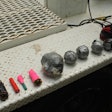There was a temptation to slug this article with the headline "Pimp Your Handgun." After all, it's catchy and it's trendy…There's only one thing wrong with it, it's dead wrong.
When you pimp something, all you really do is make it look or sound outrageous. And that's not what this article is about. It's about adding tools to your duty weapon that can add function, not just form. A light on your service weapon can help you recognize a threat before it can hurt you. A laser can improve your accuracy and even intimidate an attacker. And night sights can make it easier for you to shoot in low light conditions.
The following is a quick look at some of the newest and best tools that you can attach to your duty or off-duty handgun. It's not comprehensive. We don't have space for that. But it will give you an idea of what's available.
Low-Light Sights
TRUGLO TFO sights are fiber optic sights with tritium vials set in each fiber optic pipette. I thought, What a gimmick; this has to be a toy for competition. These things can't be tough enough for street use. I was wrong.
The TFO sight is being used by many law enforcement agencies—one of the alphabet agencies is even looking to use a carbine version on its M4s—yet very few TFO sights have been damaged on the job.
TFOs are beefier and heavier than competition tritium sights. They also have a solid base for support and are not "free" floated like competition sights. The combination makes them much more durable than competition sights.
I put a set of the TFOs on my Kimber Ultra Carry II to see how I liked them. I was really impressed. They markedly improved sight acquisition, and the sight picture was clear. The tritium vials glow nicely at night and in low light.
Currently TFOs are available for Glock, Springfield XD, Kimber 1911, and H&K USP pistols. The company is working on sights for other makes and models of duty guns.
Quick Acquisition Sights
For my personal use, I have mated the front sight of the TFO with a rear sight from 10-8 Performance. The 10-8 sight was designed by Hilton Yam, a fine pistol plumber who works for a federal agency.
The 10-8 is a beefy sight that is designed to handle anything duty can dish out. It's made from heat treated 4140 steel so it's tough and durable. The sight is tough enough to enable one-handed loading drills and it is shaped to facilitate them.
The sight blade is serrated with 40 LPI to reduce glare. Instead of a square notch the 10-8 uses a "U" notch; this allows faster acquisition of the front sight.
I have been using a 0.185 sight on my Rock River Arms Basic Carry with the 10-8, and it is dead on at 25 yards. I like the sight so much that I plan to have tritium vials put into the sight on the Rock River Arms and in the one I am installing on my Kimber Ultra Carry II. Currently 10-8 sights are available for Smith & Wesson M&Ps, Kimber, and Novak rear sight cuts.
Another sight designed by a full time federal agent and respected competitive shooter is the Warren Tactical Sight from Warren Tactical Series. The Warren Tactical Sight has quickly built a following among competition shooters and is used by Phil Strader, Julie Goloski, and Scott Warren—the designer.
The Warren Tactical Sight is one of the most unique sights on the market. It is called a wave sight because it looks like a wave. This sight gives you a sharp, crisp view of the target without obscuring the target. The effect is a larger view of a target on the range or a better view of a suspect when viewed over the handgun.
Unlike many sights on the market the WTS is not serrated. I was concerned about this creating sight glare until I shot it. There was no sight glare in the brightest or the flattest light.
Drawing from his competitive experience, Scott Warren uses a "U" notch instead of the standard box notch. This allows for faster front sight acquisition and, at close range, it works like a ghost ring, helping you set the front sight in position and simply shoot. For more precision, the top of the notch is flat, which gives you that perfect post/notch sight picture.
You can find Warren rear sights for SIGs, S&W 5906 and M&Ps, and Glocks. Front and rear tritium sight sets from Warren Tactical are available for Glocks with single-dot or two-dot rear sights. Rear sights for Springfield Armory XDs and 1911s with Novak sight cuts will be available soon.
Custom Grips
Hogue makes some of the strongest grips available for law enforcement pistols. The company's Extreme Series is machined from aluminum, titanium, and Damascus steel. The strength of these materials lets Hogue design some of the thinnest most innovative grips on the market.
Extreme aluminum grips are available in five colors: clear, black, red, blue, and green. Steel and titanium grips are also available in silver (color) and wood finish brown. Hybrid models are available with hardwood inserts. The aluminum grips are available in smooth and precision checkered finishes. All Hogue grips are easy to install.
One complaint about the polymer duty guns on the market is that they don't offer enough "grip," even when they have molded checkering. You can have the frame hand textured, but this most likely will void the manufacturers warranty and, if it's an agency issued weapon, the powers that be may frown upon it.
To get an aggressive texture without voiding the warranty, you may want to try TruGrips. These grips are custom fit for specific handguns. TruGrips are available for SIG 226/229, Smith & Wesson M&P, Springfield Armory XD and 1911, STI/SVI 1911, and Glock pistols. TruGrips come with easy to follow instructions and are easily applied.
I chose to try them on my XD9 since this has rapidly become one of my favorite pistols to shoot and carry. I wiped down the frame with the degreaser and applied the panels. The TruGrip fit just perfectly, and I like how it feels in my hand and when I am shooting wearing gloves. If you are looking for an inexpensive way to texture your polymer handgun, TruGrips is it.
Weapon Lights
The SSL-1 is Insight Technology's first all aluminum weapons light, it is durable, lightweight, and gives the operator a tightly focused beam. What sets the SSL-1 apart from other lights is the independent toggle, meaning both sides of the switch are separate. Push down for momentary on, up for constant on; both sides work the same. It's simple and effective
Many duty weapons now have light rails but not all. And even if you do have a rail on your gun, you may not want to mount a light on that rail because of holster issues, policy issues, or because you need to keep a low profile in plainclothes. Safariland has a solution for you: the RLS (Rapid Light System.)
Safariland's RLS is designed to be snapped on and off of your gun in a moment's notice. It comes with a substantial belt clip for attaching the light/mount to your belt until needed. You can use the light in your hand or you can slide it onto your handgun and use it as a weapons mounted light. To secure the RLS to your weapon, simply rotate the light and it will lock on.
The RLS operates on three AAA batteries and provides you with more than 50 hours of light. It has an output of 65 lumens, which is enough to use it as a primary weapons light. The RLS's Prism Reflector System gives you illumination out to 100 yards. Not bad for a small handheld unit.
The latest generation of SureFire weapon light, the X300 will attach to a Picatinny or a Universal rail by simply changing the lock plate; both are provided with the light. The X300 is not only versatile but with its Total Internal Reflector the LED output is 110 lumens, enough to light the darkest night.
SureFire uses O-rings to seal this light, making it water resistant to roughly 22 meters. The result is an all aluminum light that will survive the harshest environments.
The TLR-1 is Streamlight's first proprietary weapons light. The TLR-1 unlike other systems uses a self-contained clamp to secure the light to the weapons rail; much like a scope mount. The TLR-1 has passed Mil-Spec 810F performance tests, so it should survive the daily rigors of the street.
Add a Rail
If you carry a Beretta 92 or 1911 on duty and wish to add a light rail, Brownells has the solution. Instead of buying an entirely new sidearm, you can install a light rail mount. This is a standard Picatinny rail designed to fit the curve of the dust cover.
The Brownells rail is pretty easy to install. All you have to do is set the rail on your frame drill and tap the frame. Then grind the screws inside the frame so they are flush. Finally, mix up the Acraglas in the kit, apply the curve of the mount, and screw the mount in place. The Acraglas gives you a more secure bond because it fills the contours of the frame to mount fit. In 24 hours you have a Beretta or 1911 with a light mount. Check holster fit by securing the mount first with duct tape before permanently attaching the mount.
Laser Sights
I have always been skeptical about the value of mounting lasers on firearms. But after talking with such notables as Ken Hackathorn, Larry Vickers, and others I have changed my mind. Lasers give visible feedback to shooters. You can see whether you flinch, whether your barrel wanders, and you can smooth out your trigger technique
There are two main players in government and local law enforcement: Crimson Trace and LaserMax.
Crimson Trace Lasergrips are set for point of impact just like a rifle scope, except you use much smaller tools to adjust it. As the name implies, Lasergrips are built into the grip, which replaces the stock grips of your duty weapon. The grip secures the batteries, on/off switch, and the activation switch. This, of course, means that the grip has to be slightly wider than the stock grips.
On polymer frame handguns such as Glocks and M&Ps, the grip is fitted to the frame or part of the frame is replaced, neither voids warranties. Crimson Trace will soon have grips for Springfield XDs. Crimson Trace Lasergrips are used extensively by government agencies and the military.
Another popular laser sight is made by LaserMax. LaserMax lasers replace the guide rod; the on/off switch is installed in the take down pin or lever on your duty weapon. This means you won't need new holsters and your grip size will not change; for those with small hands this is a major concern. LaserMax guide rods are factory zeroed at 20 yards except for the 1911, Uni-Max, J-Max, and shotgun models, which are adjustable.
LaserMax has recently introduced the rail laser, which fits on the weapons rail under a white light. This is ideal for adding a laser to your long gun and keeping the weight and size of the combination down.
-
10-8 Performance.
-
Crimson Trace.
-
Hogue.
-
Insight Technology.
-
LaserMax.
-
Safariland.
-
Streamlight.
-
SureFire.
-
TRUGLO.
-
TruGrips.
-
Warren Tactical Series.



















